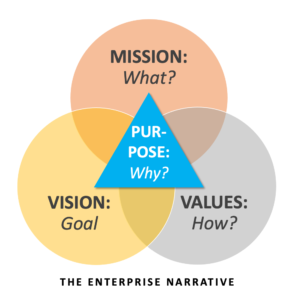
The Power of Purpose
In my recent study of corporate purpose for The Conference Board (TCB), I conclude that, “Purpose is a key element in the corporate narrative—the story a company continually tells to its various constituencies [i.e., stakeholders]. It is, in short, why the company exists. While different organizations have varying ideas of what constitutes Purpose, The Conference Board offers this simple description: Purpose is why the company does what it does.”
Purpose in context
Purpose is the driving element of the enterprise narrative: its keystone, its heartbeat, its lynchpin — choose your favorite metaphor. TCB researcher Thomas Singer defines the narrative as consisting of four integrated pieces: Purpose (Why we exist); Mission (What we do); Vision (Our goal); and Values (How we do things.) 
A powerful Purpose can be sometimes be scaled down to a single phrase. Three institutions near and dear to me do this especially well:
- The Conference Board, “Trusted insights for what’s ahead”;
- the Yale School of Management, “Educating leaders for business and society”; and
- the United States of America, “E pluribus unum” (from many, one.)
Who cares about Purpose?
Formalized Statements of Corporate Purpose (SCP) are beginning to gain traction as a powerful management tool. Singer found that, by the end of 2020, 24% of the Global S&P 1200 had formal SCPs — and that this number is growing rapidly.
Well-articulated SCPs benefit a range of stakeholders, including:
- Customers — who increasingly look to business for leadership on a range of issues
- Employees — now said to be the most influential stakeholder group for many organizations
- Owners/shareholders/investors — who were the first to point out the value of an articulated purpose
- Society — which includes everyone else, really — including regulators, the “twitterverse,” trading partners, and so on.
Purpose scales
Corporate purpose is closely related to personal purpose — or, should be in order to be most effective. The question that each of us tacitly asks ourselves, “What am I doing here?” is part of the larger “What are WE as a group doing here — and how do I fit in?”
In my recent interview with Dr. Madelyn Blair, she tells me she used these as key performance counseling questions when she was an executive at the World Bank. She even devised a test as to whether certain expenditures were sufficiently “on Purpose.”
Enterprises and individuals should each have clearly articulated purposes — and not stray far from them. Each product should have purpose. Even each meeting should have a clear purpose.
A tale of two clients
I worked recently with two nonprofits in the education services field. Similar industry — but big contrast in culture and results. One had high engagement and morale among employees, and high collaboration across silos. In contrast, the other was relatively low on both these important metrics.
In the former organization, the Purpose statement was emblazoned behind the headquarters reception desk — such that each employee walked past it on the way in. Even as a contractor, I felt ownership of my client’s Purpose. (Yes, that was in pre-pandemic days.)
In the latter organization, Purpose did not seem top-of-mind to most employees. Low individual engagement resulted in poor morale, which in turn drove tangible adverse metrics like climbing sick days and paid overtime. A coincidence? Perhaps — but our intervention for this client included specific steps for addressing shortfalls in perceived individual purpose among employees.
Planning for Purpose
Purpose that sticks doesn’t just happen — it takes planning and sustained work. I’ve done it successfully for a nonprofit client, and less-than-successfully for a large corporate division. (This latter because we discovered that they had deeper problems that an SCP would merely dress up, not fix.)
To do purpose right, these steps are essential:
- Build internal engagement and support — from the C-suite and even the Board
- Identify and map key stakeholders who will be audiences for the purpose
- Engage key individuals within each of those stakeholder groups. Capture their views on the enterprise purpose in a systematic way
- Iterate language; build consensus, adoption, and buy-in
- Build Purpose into enterprise governance and management — as below
Benefits of Purpose
Though it’s not a panacea, a clearly-articulated enterprise Purpose typically provides these benefits:
- As an enterprise, Purpose binds us together. It empowers us to work toward the same goals.
- As individuals, Purpose motivates and inspires us to perform – it’s at the top of the hierarchy of intention
- Purpose signals to the world who we are. It’s like an influential elevator pitch for key audiences, both internal and external – customers, employees, owners/investors, and society at large.
- Purpose helps us manage change. It cushions the impact of change on our enterprise by enabling adaptive resilience— for example, value model pivots in times of stress or volatility.
Challenges for Purpose
Few things worth achieving are easy or painless. What are some of the potential downsides of Purpose?
- Lack of substance — Purpose statements often end up stuffed with generic feel-good language that is not specific to the organization.
- Greenwashing — Purpose statements without accompanying actions are (rightfully) seen as bandwagon-ish PR, not as serious governance.
- Lack of accountability — Since there’s no one checking up on Purpose at arm’s length, there is little in the way of systematic accountability.
Purpose my word for 2022. Loved reading this!
Thanks so much, Ellen! Yes, purpose is construct whose time has definitely come.